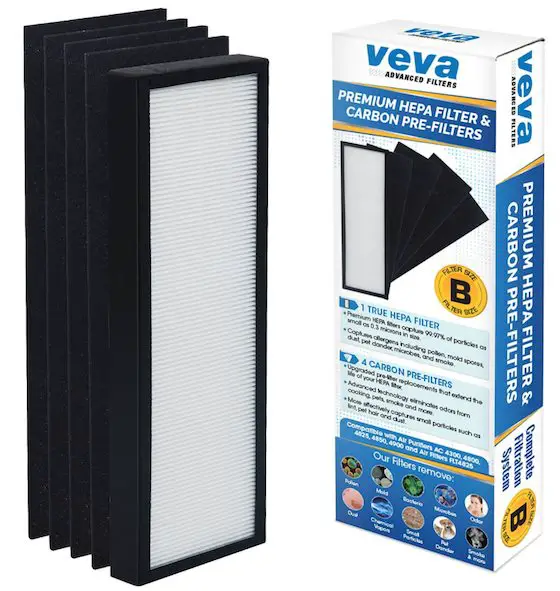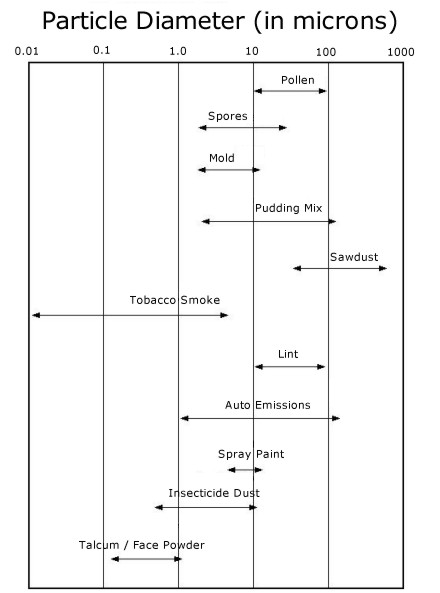Air Filter Particle Size Chart
Air Filter Particle Size TIPS
- Cheap fiberglass furnace filters are for catching HUGE things
- Paper pleated filters are superb
- WATCH filter VIDEO below
- HEPA filters are affordable and they work.
- CLICK HERE to Get Tim's Free & Funny Newsletter!
Dust. pollen, mold float around your house every day in massive numbers. Now, I'm not trying to scare or upset you, it simply is a fact. Well, how would you like to be able to sift many of these particles from the air economically and efficiently?
Planes, Trains & Cars
What in the world do these things have to do with air? Well, all three of these massively complex machines have engines which use sophisticated air filtration equipment. Most of these filters are pleated paper filters, not spun glass. These paper filters easily trap extremely small pieces of dust and dirt that can cause costly damage.
What's more important? An engine or your lungs? So, why in the world are you still using one of those inexpensive fiberglass filters in your furnace or air conditioning equipment? I'll tell you why. For years, we (you & me) thought that those were the filters to use.
Did you know that those filters are not meant to purify the air you breathe? I'm serious. Their sole function is to keep LARGE particles of dirt, dust, hair, etc. from clogging the furnace and air conditioning equipment. Dirt, hair, etc. can clog coils, coat electric motors (causing overheating), and coat fan blades (causing inefficient air movement). It's your job to watch out for your own body.
Great Filter Overview Video
Watch this video to get an idea of all the different filters. You'll see how the crap fiberglass ones have low MERV ratings.
Free & Fast Bids

If you want to STOP things from getting into your lungs in your house, then you need HEPA filters like this. CLICK THE PHOTO now to have these delivered to your home.
If this is a shock to you, well, welcome to the club! Until I did the research for this particular column and bulletin, I too, thought that the spun glass filters did a fairly decent job of air filtration. They do, it just depends upon who they are working for (the furnace or your lungs!).
Efficiency vs. Arrestance
Air filter performance is measured using a quite sophisticated testing procedure. Two of the things that are measured are the filter's efficiency and its ability to "arrest" or stop particles dead in their tracks. This is called arrestance. These two things are really quite different.
Efficiency is a measurement of how quickly a filter is stained by test dust. The measurement is determined by how much light passes through the filter at different time periods. As the filter gets more clogged with dirt, the less light it will transmit. Spun glass filters are so inefficient, that they do not even qualify for this test! They simply don't have the capability to trap enough fine test dust particles.
Arrestance a very interesting test. In this test, a certain weight of very specific test dust is fed into the test chamber. This test dust is made up of dust gathered from the desert area of Arizona, powdered carbon, and cotton linter fibers.
Prior to the test, the filter is accurately weighed. After the test, the filtered is weighed again. It's increase in weight is compared with the total weight of the test dust introduced. Comparing these two simple numbers enables you to see how effectively the filter traps or "arrests" dirt and dust.
You really need to pay attention to how a filter is advertised. Most good paper filters can arrest maybe 90% of the particles, however they may only have an efficiency of 20 - 30%. Purchasing a filter that is 20 -30% efficient is a huge improvement over the spun glass filters. Some of these filters are only 6 - 8% efficient. That is a HUGE difference!
Pleats
The paper filters are made like car air and oil filters. These filters use pleated paper. By folding and pleating paper, you dramatically increase the square foot area available to trap dirt, dust, and pollen.
The pleats work to your advantage with respect to periodic replacement. Often a pleated paper filter might have 2 - 4 times the square foot area of a similar spun glass filter. This means that you quite possibly can leave it in your furnace for 3 - 4 times longer than a spun glass filter. When this is considered, these paper filters cost just about the same per month, as a spun glass filter.
Even if you have to spend twice as much per month, they are worth it. These pleated paper filters can keep your house and lungs quite clean.
Synthetic Fiber Filters
You can also purchase efficient air filters made from synthetic polyester fibers. Sometimes these filters are treated with an adhesive which helps trap dust and dirt particles. Efficiency and arrestance capabilities can match those of the paper filters.
Microns
A micron is a form of measurement, just like an inch or a mile. But, it is much, much smaller than both of those. A micron is one-millionth of a meter or equivalent to 1/25,400 th of an inch. Man, that's small!
The filters we have been talking about can trap some pretty small particles. For example, some of these filters can trap mold spores and pollen. These particles often range in the differ size from 5 - 10 microns in diameter. To put that in perspective to things we are more familiar with, lets look at a strand of ordinary hair. I think you will agree that a piece of hair is pretty darned thin. Guess what, an average hair is approximately 150 microns wide!
That should give you an idea of how effective some of these paper and synthetic fiber filters can actually be.

If you want to STOP things from getting into your lungs in your house, then you need HEPA filters like this. CLICK THE PHOTO now to have these delivered to your home.
Bacteria, Viruses, Mold, etc.
If you suffer from allergies related to the above items, these filters may be of interest to you. In certain cases, they can stop certain molds and fungi. They are somewhat less effective in stopping bacteria, as bacteria range in size from .1 microns all the way up to 60 microns. Viruses are another story. Most of these are quite small. They usually range in size from .01 to .2 microns in size. To trap viruses, you need special air filters and modifications to your furnace blower. The filters that trap viruses are also expensive. They are used in hospital environments to limit the spread of disease.
Most of us do not need this level of protection. Shop around for a pleated paper filter and the trip will be worth it. Once installed, you will readily see the difference in your home. No more dusting of the furniture!
Particle Size Comparison Chart in Microns
The below chart illustrates the relative size of some common dust, dirt, pollen, mold, etc. particles that you might recognize by name. Particles of the same thing are not always the exact same size. In fact, there can be huge variances. That is why they are shown, on this chart, by a line. The line dictates the size range of each particle.

Column B79
5 Responses to Air Filter Particle Size Chart